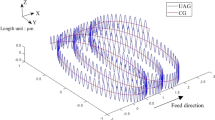Abstract
Ultrasonic vibration assisted grinding is an advanced method for machining difficult-to-process materials such as SiCp/Al composites. This paper presents a mechanics model for predicting grinding forces in ultrasonic vibration assisted grinding of SiCp/Al composites. It consists of side grinding force model and end grinding force model. In side grinding force model, the major components are the normal force and tangential force in which the analytical expressions for the chip formation force based on Rayleigh’s probability density function, the frictional force, and the particle fracture force based on Griffith theory are established, respectively. In contrast, the axial force developed based on the indentation theory is the major component in end grinding force model. The coefficients in the proposed grinding force model were obtained through two groups of orthogonal experiments. Based on the mechanics prediction model, the relationship between grinding forces and process variables were predicted. At last, two groups of single factor experiments were conducted to verify the proposed grinding force model and experimental results were found to agree well with predicted results.
Similar content being viewed by others
References
Wang Y, Lin B, Zhang XF (2014) Research on the system matching model in ultrasonic vibration-assisted grinding. Int J Adv Manuf Technol 70(1–4):449–458. doi:10.1007/s00170-013-5269-2
Shen XH, Zhang JH, Xing DLX, Zhao YF (2012) A study of surface roughness variation in ultrasonic vibration-assisted milling. Int J Adv Manuf Technol 58(5–8):553–561. doi:10.1007/s00170-011-3399-y
Bertsche E, Ehmann K, Malukhin K (2012) An analytical model of rotary ultrasonic milling. Int J Adv Manuf Technol 65(9–12):1705–1720. doi:10.1007/s00170-012-4292-z
Zhou M, Zhao P (2016) Prediction of critical cutting depth for ductile-brittle transition in ultrasonic vibration assisted grinding of optical glasses. Int J Adv Manuf Technol:1–10. doi:10.1007/s00170-015-8274-9
Mahaddalkar PM, Miller MH (2014) Force and thermal effects in vibration-assisted grinding. Int J Adv Manuf Technol 71(5–8):1117–1122. doi:10.1007/s00170-013-5537-1
Kishawy HA, Kannan S, Balazinski M (2004) An energy based analytical force model for orthogonal cutting of metal matrix composites. CIRP Ann Manuf Technol 53(1):9–94. doi:10.1016/S0007-8506(07)60652-0
Pramanik A, Zhang LC, Arsecularatne JA (2006) Prediction of cutting forces in machining of metal matrix composites. Int J Mach Tool Manuf 46(14):1795–1803. doi:10.1016/j.ijmachtools.2005.11.012
Davim JP (2007) Application of Merchant theory in machining particulate metal matrix composites. Mater Des 28(10):2684–2687. doi:10.1016/j.matdes.2006.10.015
Dabade UA, Dapkekar D, Joshi SS (2009) Modeling of chip-tool interface friction to predict cutting forces in machining of Al/SiCp composites. Int J Mach Tool Manuf 49(9):690–700. doi:10.1016/j.ijmachtools.2009.03.003
Sikder S, Kishawy HA (2012) Analytical model for force prediction when machining metal matrix composite. Int J Mech Sci 59(1):95–103. doi:10.1016/j.ijmecsci.2012.03.010
Du JG, Li JG, Yao YX, Hao ZP (2014) Prediction of cutting forces in mill-grinding SiCp/Al composites. Mater Manuf Process 29(3):314–320. doi:10.1080/10426914.2013.864402
Ghandehariun A, Hussein HM, Kishawy HA (2015) Machining metal matrix composites: novel analytical force model. Int J Adv Manuf Technol 83(1):233–241. doi:10.1007/s00170-015-7554-8
Feng PF, Liang GQ, Zhang JF (2014) Ultrasonic vibration-assisted scratch characteristics of silicon carbide-reinforced aluminum matrix composites. Ceram Int 40(7):10817–10823. doi:10.1016/j.ceramint.2014.03.073
El-Gallab M, Sklad M (1998) Machining of Al/SiC particulate metal matrix composites - part II: workpiece surface integrity. J Mater Process Technol 83(1–3):277–285. doi:10.1016/S0924-0136(98)00072-7
Tang JY, Du J, Chen YP (2009) Modeling and experimental study of grinding forces in surface grinding. J Mater Process Technol 209(6):2847–2854. doi:10.1016/j.jmatprotec.2008.06.036
Patnaik Durgumahanti US, Singh V, Venkateswara Rao P (2010) A new model for grinding force prediction and analysis. Int J Mach Tools Manuf 50(3):231–240. doi:10.1016/j.ijmachtools.2009.12.004
Hecker RL, Liang SY, Wu XJ, Xia P, Jin DGW (2007) Grinding force and power modeling based on chip thickness analysis. Int J Adv Manuf Technol 33(5–6):449–459. doi:10.1007/s00170-006-0473-y
Agarwal S, Rao PV (2013) Predictive modeling of force and power based on a new analytical undeformed chip thickness model in ceramic grinding. Int J Mach Tool Manuf 65:68–78. doi:10.1016/j.ijmachtools.2012.10.006
Tohgo K, Itoh T (2005) Elastic and elastic–plastic singular fields around a crack-tip in particulate-reinforced composites with progressive debonding damage. Int J Solids Struct 42(26):6566–6585. doi:10.1016/j.ijsolstr.2005.04.013
Xiao XZ, Zheng K, Liao WH (2014) Theoretical model for cutting force in rotary ultrasonic milling of dental zirconia ceramics. Int J Adv Manuf Technol 75(9–12):1263–1277. doi:10.1007/s00170-014-6216-6
Zhang CL, Zhang JF, Feng PF (2013) Mathematical model for cutting force in rotary ultrasonic face milling of brittle materials. Int J Adv Manuf Technol 69(1–4):161–170. doi:10.1007/s00170-013-5004-z
Yuan ZW, Li FG, Chen B, Xue FM, Hussain MZ (2014) Further investigation of particle reinforced aluminum matrix composites by indentation experiments. J Mater Res 29(4):586–595. doi:10.1557/jmr.2014.15
Yuan ZW, Li FG, Xue FM, Zhang MJ, Li J (2015) An investigation of micro-mechanical properties of Al matrix in SiC/Al composite by indentation experiments. J Mater Eng Perform 24(2):654–663. doi:10.1007/s11665-014-1350-8
Yuan ZW, Li FG, Zhang P, Chen B, Xue FM (2014) Mechanical properties study of particles reinforced aluminum matrix composites by micro-indentation experiments. Chin J Aeronaut 27(2):397–406. doi:10.1016/j.cja.2014.02.010
Author information
Authors and Affiliations
Corresponding author
Rights and permissions
About this article
Cite this article
Zhou, M., Zheng, W. A model for grinding forces prediction in ultrasonic vibration assisted grinding of SiCp/Al composites. Int J Adv Manuf Technol 87, 3211–3224 (2016). https://doi.org/10.1007/s00170-016-8726-x
Received:
Accepted:
Published:
Issue Date:
DOI: https://doi.org/10.1007/s00170-016-8726-x



